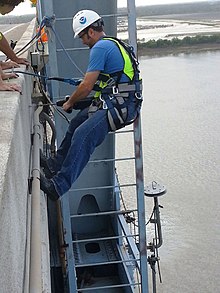Safety harness
This article has multiple issues. Please help improve it or discuss these issues on the talk page. (Learn how and when to remove these template messages)
|

A safety harness is a form of
An unrelated use with a materially different arresting mechanism is bungee jumping. Though they share certain similar attributes, a safety harness is not to be confused with a climbing harness used for mountaineering, rock climbing, and climbing gyms. Specialized harnesses for animal rescue or transfer, as from a dock to a vessel, are also made.
Safety harnesses have restraints that prevent the wearer from falling from a height. By wearing the belt or harness the risk of injury from a fall is greatly reduced. The harness allows the user to attach themselves to an object that is stationary, ensuring they will not hit the ground in the event of a possible fall. Falling from high areas is one of the most common causes of injuries in the workplace, so it is very important to make sure you are properly equipped when working up high.
Before safety harnesses were required by OSHA (The Occupational Safety and Health Administration), workers wore body belts to connect to fall protection systems. Workers had the belts fastened around the waist, resulting in the entire force being exerted on the abdomen and often causing significant injury.
OSHA implementing this requirement really made sure the amount of casualties decreased from falling, as well as injuries caused from the old belts they used to wear. Safety harnesses are essential while working in high areas to prevent significant injury or death, and OSHA making these a requirement made everyone understand the importance of safety-harnesses
Standards
In North America, safety harnesses designed for protection against falls from heights in industrial and construction activities are covered by performance standards issued by the American National Standards Institute (ANSI) in the United States and by CSA Group (formerly known as the Canadian Standards Association) in Canada. Specifically, the standards issued are ANSI Z359.1,[1] and CSA Z259.10.[2] These standards are updated approximately every four to five years. The main purpose of the safety standards is to "act as a standard to drive best-in-class harnesses through rigorous design and test requirements. in addition to having requirements for manufacturers to create an ANSI-approved full body harness." The update to Z359.11 includes revisions and new requirements, including A modified, headfirst, dynamic test procedure, New stretch-out requirements for frontal connections, Alternative fall arrest indicator testing and new label requirements, Allowance for harnesses with integrated energy absorbers, and Changes to labeling requirements. It. requires harness label packs to have pictograms showing the approved usage of different connections and diagrams explaining the difference between deployed and non-deployed visual load indicators. These new standards help give the user a level a confidence, while knowing it has gone through rigorous testing to ensure that what you are using is completely safe and effective.
Classifications
There are four classes of fall protection systems:
- Class 1 is body belts (single or double D-ring), designed to restrain a person in a hazardous work position, prevent a fall, or arrest it completely within 3 feet (90 cm) (OSHA).
- Class 2 is chest harnesses, used only with limited fall hazards (including no vertical free fall), or for retrieving persons, as from a tank or bin.
- Class 3 is full body harnesses, designed to arrest the most severe free falls.
- Class 4 is suspension belts, independent supports used to suspend a worker, such as boatswain's chairs or raising or lowering harnesses.
Other types
Other forms of safety harnesses include
Uses
Fall arrest
A fall arrest harness is the equipment which safely stops a person already falling.
A
Climbing
A climbing harness is a device which allows a climber access to the safety of a rope.
Guide or support
A jackstay harness is a substantial line between two points used to guide or support.
Bungee jumping requires a harness to get the person to bounce back up, without it there would be no way to prevent the jumper from falling straight to the ground. In motorsport harnesses keep the driver secure in the event of a crash, keeping the driver secured in place gives the person more of a chance to leave without injury.
Diving
A
A
Inspection
To be sure that a safety harness is not going to fail when in use there are things the user needs to check before they put their lives in the hands of said equipment. The main problem would most likely be frying from prior usage. Another problem would be from improper storage and that would be cracks in the harness, this would make the harness much less durable and much weaker. Finally the wearer needs to be sure to check the fasteners for damage so that part does not fail independently from the harness itself.
References
- ^ Kelechava, Brad (5 January 2021). "ANSI/ASSP Z359.1-2020: The Fall Protection Code". The ANSI Blog.
- ^ "Changes in CSA Z259.10-18: Full Body Harnesses" (PDF). 3M.
- "ANSI / ASSP Z359 Fall Protection and Fall Restraint Standards". assp.org. American Society of Safety Professionals. Archived from the original on May 27, 2020. Retrieved June 4, 2020.
- "CAN/CSA-Z259.10-12 (R2016) - Standards Council of Canada - Conseil canadien des normes". scc.ca. Standards Council of Canada. Retrieved June 4, 2020.
- "What the Updated Z359.11 Standard Means for Full Body Harnesses". American Society of Safety Professionals. Retrieved 2023-04-10.
- "Fall Protection Information". Archived from the original on 2016-08-04. Retrieved 2017-03-17
- . "When to Use a Safety Harness". www.safety-harness.com. Retrieved 2023-04-10
- "TODO". SafetyLiftinGear. Retrieved 2023-04-10.
- Roux, Lance. "Harness Safety Facts and Tips". www.safetyproresources.com. Retrieved 2023-05-01.
- Admin, FallTech. "The Complete Guide to Full Body Harnesses". blog.falltech.com. Retrieved 2023-05-01.
- "Fall Protection Safety Harness Guide". SafetyCulture. Retrieved 2023-05-01.
